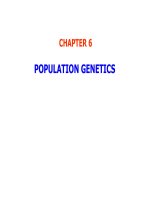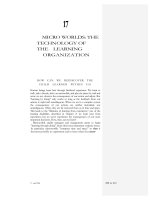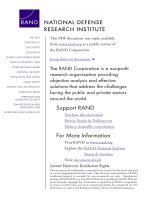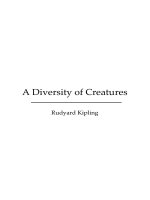micro diversity
Bạn đang xem bản rút gọn của tài liệu. Xem và tải ngay bản đầy đủ của tài liệu tại đây (204.03 KB, 21 trang )
CHAPTER 6
POPULATION GENETICS
• A population is a localized group of individuals
belonging to the same species.
•
A species as a group of populations whose
individuals have the potential to interbreed
and produce fertile offspring in nature.
•
Gene pool is the complete set of genetic
information contained within the individuals
in a population. The gene pool includes all alleles
present in the population.
Principal points
Principal points
• Evolution is a process in which genetic variation
in a population changes over time.
•
Genetic variation originates when one allele
mutates to another.
•
Population genetics studies the origin of
variation, the transmission of variants from
parents to offspring generation after generation.
i.e., population genetics is the branch of genetics
that deals with frequencies of alleles and
genotypes in breeding populations.
-
Genotype frequency in a population is the proportion
of organisms that have the particular genotype (eg.
RR, Rr
or
rr
).
-
Allele frequency is the proportion of all alleles that are
of the specified type (eg.
R
or
r
).
Frequencies of Alleles & Genotypes
Frequencies of Alleles & Genotypes
Suppose, these are diploid organisms:
+ There are only two allelic forms of
the gene in the population.
+ There are a total of 1,000 copies
of gene for flower color in the
population of 500 individuals.
A gene has two alleles
(R
and
r),
their frequencies are represented:
p
= 0.8 (frequency of
R
allele)
q
= 0.2 (frequency of
r
allele)
p
+
q
= 0.8 + 0.2 = 1
-
The frequency of homozygous individuals for dominant
allele (
RR
) is 320/500 = 0.64 = 64 %; and for recessive
allele (
rr
) is 0.04 (4%) in the population of 500 individuals.
+ The frequency of heterozygous individuals
(Rr)
in the
population is 0.32 = 32%.
-
The frequency of the
R
allele in the gene pool of this
population is
p
= 800/1,000 = 0.8 = 80%. And the
r
allele
must have a frequency of
q
= 0.2 = 20%.
+ The chance that the gamete will bear an
R
allele is 80%,
and the chance that the gamete will have an
r
allele is 20%.
Results of gene pool in parent population:
p
+
q
= 1
p
and
q
are the proportions of the two alleles of a gene in a population
- The relationship between
p
and
q
:
Gene pool of next generation
- The probability of picking two
R
alleles:
p
2
= 0.8x0.8 = 0.64,
i.e., about 64% of the plants have the genotype
RR
.
+ The frequency of
rr
individuals:
q
2
= 0.2 x 0.2 = 0.04 (4%)
+ And the frequency of
heterozygous plants (
Rr
+
rR
):
2pq
=
2 x 0.8 x 0.2 = 0.32 (32%)
The genotype frequencies add up to 1: 0.64+0.32+0.04=1
This is: (
p
+
q
)
2
=
p
2
+ 2
pq
+
q
2
= 1
-
The allele frequencies are the same as the allele frequencies
in the parent population. The chance that the gamete will
bear an
R
allele is 0.8, and the chance that the gamete will
have an
r
allele is 0.2. This is
p
+
q
= 1
The frequencies of alleles and genotypes remain the same
between one generation (a) and the next generation (b)
Results of gene pool in next generation:
-
The Hardy-Weinberg law states that “allele and
genotype frequencies in a population remain
constant generation after generation if there is no
selection, mutation, migration or random drift”
i.e
.: the frequencies of three genotypes
RR, Rr
and
rr
for a locus with two alleles (
R
and
r
) will
remain constant at
p
2
,
2pq
and
q
2
where
p
and
q
are the frequencies of alleles
R
and
r
, respectively.
Such populations are said to be at an equilibrium
Hardy – Weinberg law
Hardy – Weinberg law
-
Hardy-Weinberg equilibrium since their allele
and genotype frequencies are constant or
unchanging from one generation to the next









